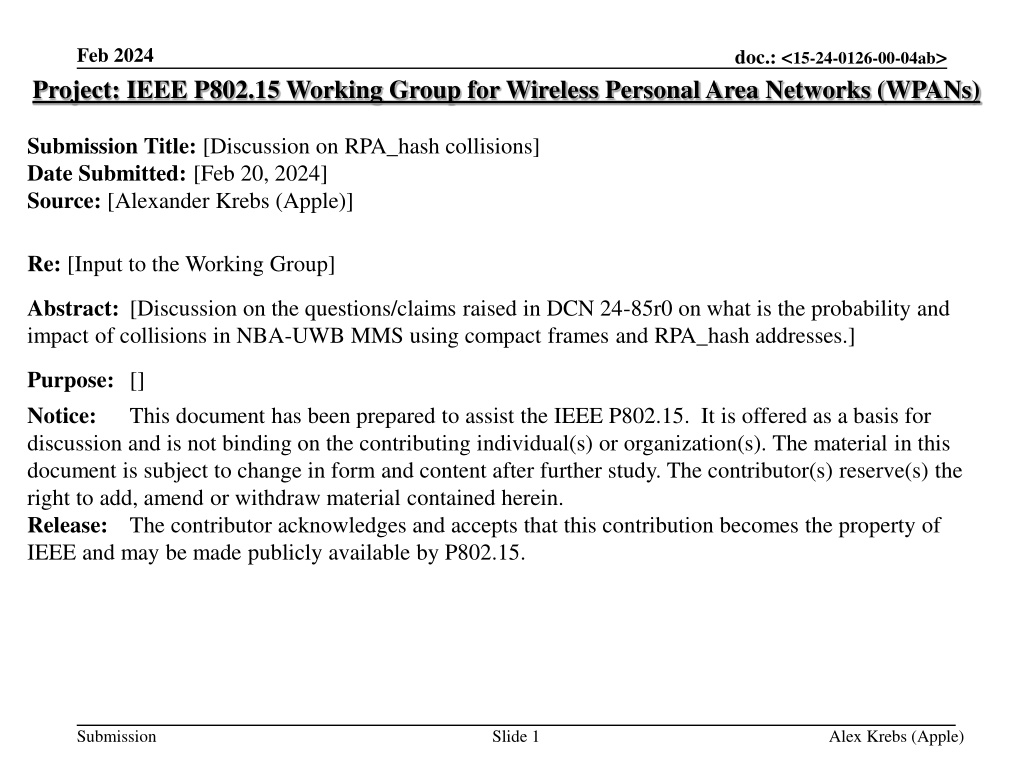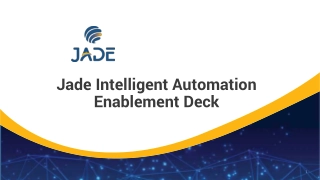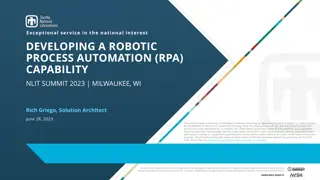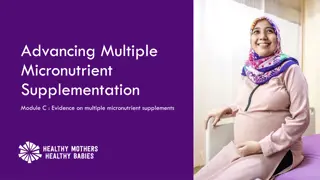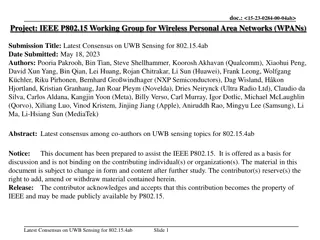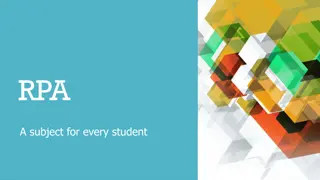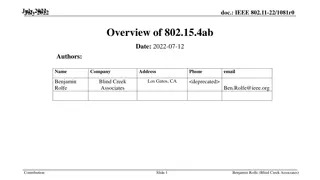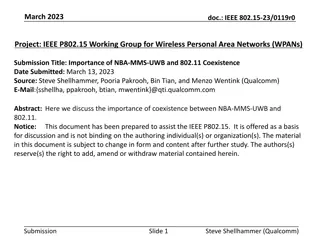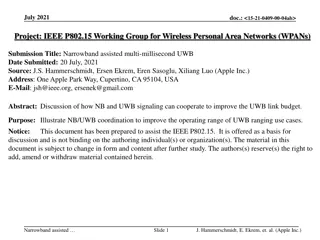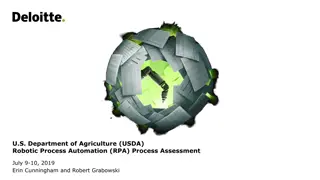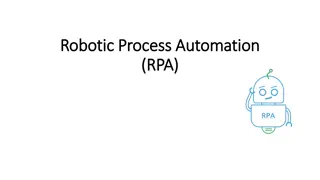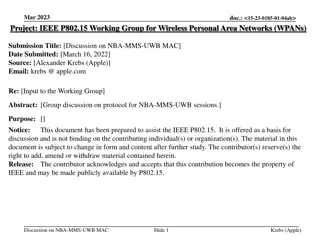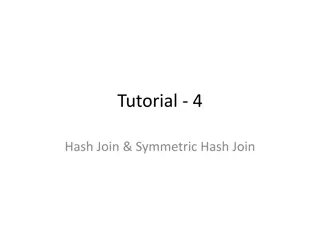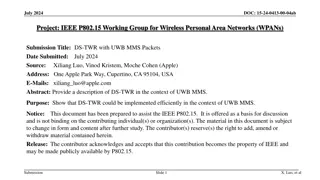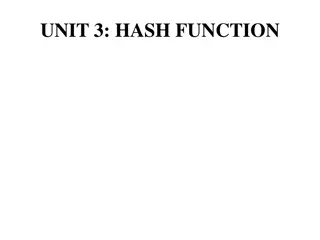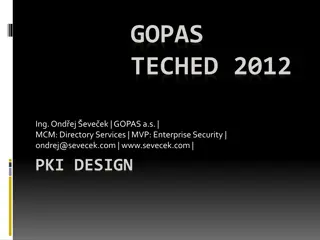Discussion on RPA_hash collisions in NBA-UWB MMS
This document explores the probability and impact of collisions in Near Band Ultra-Wideband Multi-Master Synchronization (NBA-UWB MMS) using compact frames and RPA_hash addresses. It discusses operational points, support for users without collisions, and potential effects of collisions at those points.
Uploaded on Feb 18, 2025 | 0 Views
Download Presentation

Please find below an Image/Link to download the presentation.
The content on the website is provided AS IS for your information and personal use only. It may not be sold, licensed, or shared on other websites without obtaining consent from the author.If you encounter any issues during the download, it is possible that the publisher has removed the file from their server.
You are allowed to download the files provided on this website for personal or commercial use, subject to the condition that they are used lawfully. All files are the property of their respective owners.
The content on the website is provided AS IS for your information and personal use only. It may not be sold, licensed, or shared on other websites without obtaining consent from the author.
E N D
Presentation Transcript
Feb 2024 doc.: <15-24-0126-00-04ab> Project: IEEE P802.15 Working Group for Wireless Personal Area Networks (WPANs) Submission Title: [Discussion on RPA_hash collisions] Date Submitted: [Feb 20, 2024] Source: [Alexander Krebs (Apple)] Re: [Input to the Working Group] Abstract: [Discussion on the questions/claims raised in DCN 24-85r0 on what is the probability and impact of collisions in NBA-UWB MMS using compact frames and RPA_hash addresses.] Purpose: [] Notice: discussion and is not binding on the contributing individual(s) or organization(s). The material in this document is subject to change in form and content after further study. The contributor(s) reserve(s) the right to add, amend or withdraw material contained herein. Release: The contributor acknowledges and accepts that this contribution becomes the property of IEEE and may be made publicly available by P802.15. This document has been prepared to assist the IEEE P802.15. It is offered as a basis for Submission Slide 1 Alex Krebs (Apple)
Feb 2024 doc.: <15-24-0126-00-04ab> PAR Objective Safeguards so that the high throughput data use cases will not cause significant disruption to low duty-cycle ranging use cases Interference mitigation techniques to support higher density and higher traffic use cases Other coexistence improvement Backward compatibility with enhanced ranging capable devices (ERDEVs) Improved link budget and/or reduced air-time Additional channels and operating frequencies Improvements to accuracy / precision / reliability and interoperability for high-integrity ranging Reduced complexity and power consumption Hybrid operation with narrowband signaling to assist UWB Proposed Solution (how addressed) Discussion on the questions/claims raised in DCN 24-85r0 on what is the probability and impact of collisions in NBA-UWB MMS using compact frames and RPA_hash addresses. Enhanced native discovery and connection setup mechanisms Sensing capabilities to support presence detection and environment mapping Low-power low-latency streaming Higher data-rate streaming allowing at least 50 Mbit/s of throughput Support for peer-to-peer, peer-to-multi-peer, and station-to- infrastructure protocols Submission Infrastructure synchronization mechanisms Slide 2 Alex Krebs (Apple)
Feb 2024 doc.: <15-24-0126-00-04ab> DCN 23-85 What is the operational point for NBA-UWB MMS how many users can it support w/o RPA_hash collisions? At the operational point, do RPA_hash collisions cause any effect? If so, what? Submission Slide 3 Alex Krebs (Apple)
Feb 2024 doc.: <15-24-0126-00-04ab> Proposal/Assumption/Requirement The limiting operating point is where ranging does not work after/for 3 seconds Submission Slide 4 Alex Krebs (Apple)
Feb 2024 doc.: <15-24-0126-00-04ab> Bottleneck where? Initialization broadcast packet, N receiver listening 1 channel Ranging P2P packet, only 1 receiver listening up to 250 ranging channels +/-100ppm search window for O- QPSK preamble bottleneck Submission Slide 5 Alex Krebs (Apple)
Feb 2024 doc.: <15-24-0126-00-04ab> How many users < 3 seconds? Model for packet error rate a = ADV-POLL packet duration (e.g. 500us) b = Block duration (i.e. advertising interval, e.g. 100ms) N = number of initiators broadcasting ADV-POLL packets P(N) = min(1, 2*a/b*N) Model for hash collision rate P(k) = 1-n!/(n-k)!/n^k approximation from DCN 85 (slide 8) is fine, too Expected delay until first successful ADV-POLL (first w/o OTA packet collision) d = b/(1-P(N)) Expected delay until 3 successful packets (ADV-POLL+RESP+SOR) d = b/(1-P(N))^3 (simplifying assumptions: all packets have same collision probability and collisions are i.i.d.) resolve for N to find number of initiators supported at acceptable delay d=3 seconds Submission Slide 6 Alex Krebs (Apple)
Feb 2024 doc.: <15-24-0126-00-04ab> 100ms ADV-POLL interval p=0.99 100000s SOR latency p=0.68 3s SOR latency p=0.0037 p=0.004 459 113 Submission Slide 7 Alex Krebs (Apple)
Feb 2024 doc.: <15-24-0126-00-04ab> 1s ADV-POLL interval p=1-1/3^(1/3) 3s SOR latency p=0.004 367 Submission Slide 8 Alex Krebs (Apple)
Feb 2024 doc.: <15-24-0126-00-04ab> Okay, 0.4%, but what if??? Let s ignore that UWB link budget and the UWB channel is limiting the user capacity of the system to fewer than 367... Then, after an average of 3 seconds anSOR packet reaches the wrong responder and a ranging session is started The initiator will send a POLL packet with a new RPA_prand The probability of the RPA_hash *again* colliding with the *same* value is 1/2^24 Therefore 0.4% divided by 16777216 is the chance of starting a ranging session with a wrong responder (that fails if RIFs/MICs/etc. are used...) Chances are 1 : 4194304000 Submission Slide 9 Alex Krebs (Apple)
Feb 2024 doc.: <15-24-0126-00-04ab> Okay, but what about random POLL collisions POLLs are only sent in 100ppm sync state on up to 250 AES randomized channels In order to get confused with another POLL P = 0.4% * 1/250 * 100ppm = 1/625000000 Also, the genuine POLL needs to drop below -10dB SIR over the interfering POLL which is not accounted in the equation above, as otherwise it would result in a packet collision Let s say that s the case with 100% probability, then with in 1 out of 625million cases Ranging succeeds with the wrong responder (RSF only) Ranging fails (when RIFs or MICs are used) Conflict is resolved when (whichever comes first) Either initator or responder hop to another channel (typically after 1 ranging block) The initiator sets a new RPA_prand Submission Slide 10 Alex Krebs (Apple)
Feb 2024 doc.: <15-24-0126-00-04ab> Conclusion Even with 459 initiators transmitting simultaneously in wireless range, the probability of one or more hash collisions is ~0.4% and probability of this resulting in a ranging error is less than ~0.00000016% If each of the 459 initiators were transmitting an RPA_hash every 100ms, each initiator would suffer from 1 ranging error only every 723 days The RPA hash collision issue as suggested in DCN 85r0 is insignificant: system performance is limited by OTA packet collisions Submission Slide 11 Alex Krebs (Apple)
Feb 2024 doc.: <15-24-0126-00-04ab> Appendix Submission Slide 12 Alex Krebs (Apple)
Feb 2024 doc.: <15-24-0126-00-04ab> Claim 1: Submission Slide 13 Alex Krebs (Apple)
Feb 2024 doc.: <15-24-0126-00-04ab> Proof 1: FALSE Assumption: AES input/output bits are i.i.d. The probability of obtaining M different RPA_hashes when picking N input values is (N picks out of urn with M balls) p=1-((M-1)/M)^N Eg. for N=M=2^24: p=~63% (u=M*p=10603244, which is heuristically approximated as 10.6million in DCN 85) However, other than claimed in DCN 85, there are N=2^(128+24) input values and M=2^24 output values, resulting p=1 and u=M*p = 16777216 Submission Slide 14 Alex Krebs (Apple)
Feb 2024 doc.: <15-24-0126-00-04ab> Claim 2: Submission Slide 15 Alex Krebs (Apple)
Feb 2024 doc.: <15-24-0126-00-04ab> Proof 2: FALSE n!/(n-1)! = n n/n^k = 1/n^(k-1) P(k) = 1-1/n^(k-1) is obviously incorrect as it is the complement probability of picking k-1 times the same ball from an urn of n balls (ie. probability of having at least 2 non-colliding RPA_hashes) The correct formula is the complement probability of k distinct balls picked from an urn of n balls: P(k) = 1-n!/(n-k)!/n^k (which can easily be computed as 1 - n/n * (n-1)/n * ... * (n-k)/n p=1; for i = 1 to k; do p=p*(n-i)/n; done; print 1-p) Submission Slide 16 Alex Krebs (Apple)
